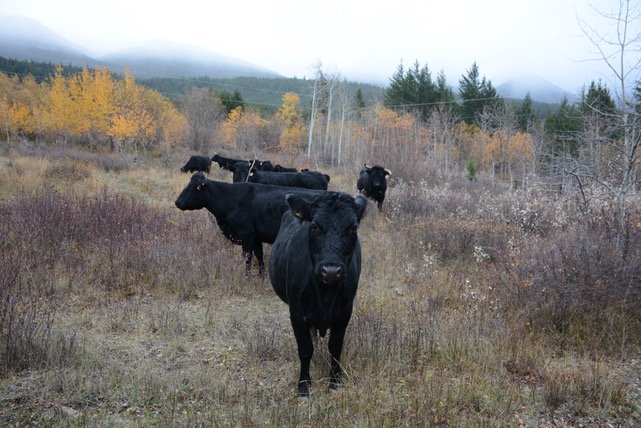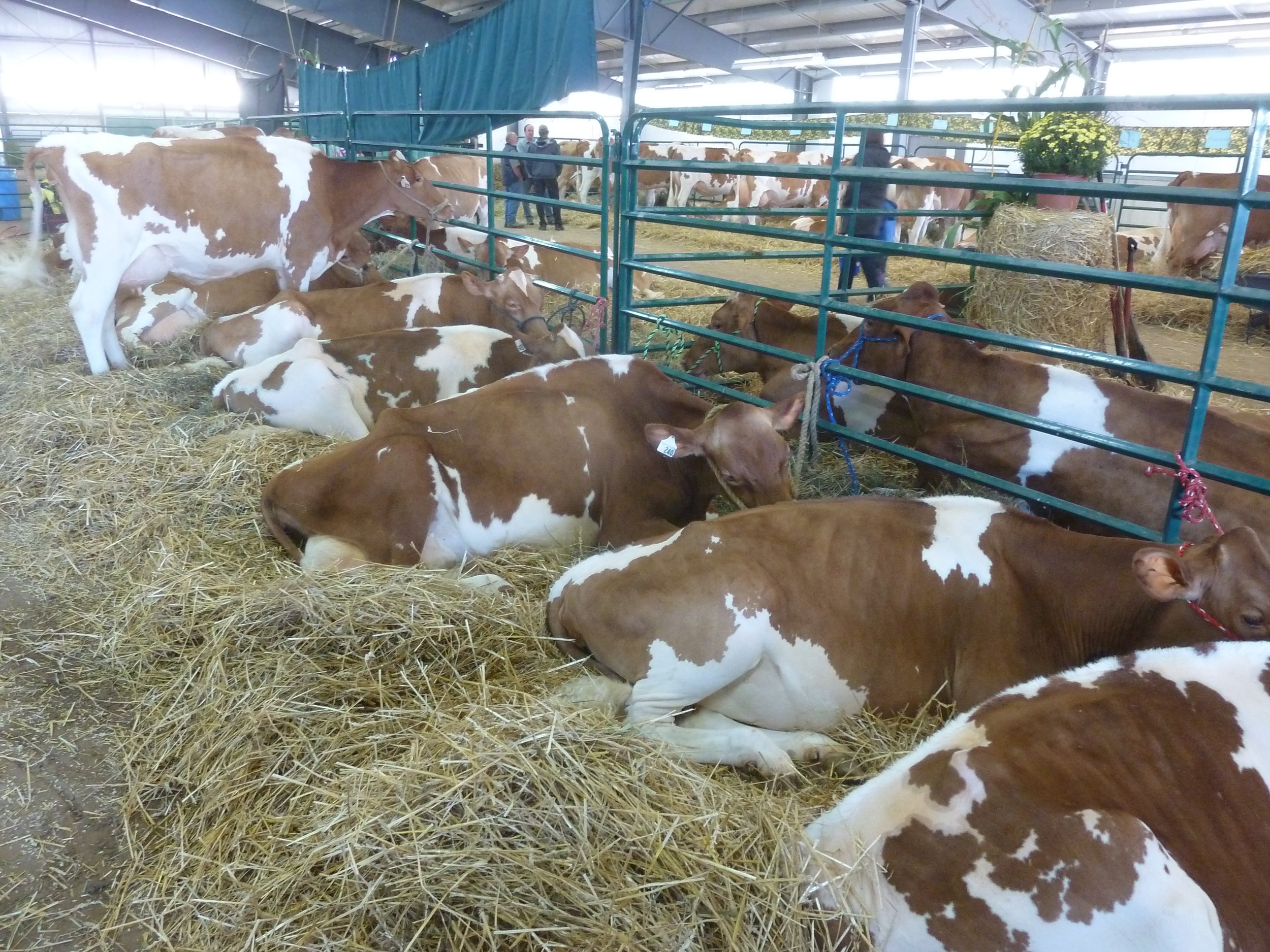
Heritage Dairy Breeds
Breeds from the past, ideal for the future of dairy farming, with a naturally low carbon footprint
Heritage dairy cattle breeds can be suitable for use in various dairy settings. These cows are equally at home in a home, micro and conventional dairy setting.
Canadienne in a home setting. Being milked using a portable system.
HLC Dairy Cattle Representative, Tara Wilson demonstrates how easily her Canadienne adapt to a portable milking system.
Heritage Dairy Breeds
-

Canadienne
Descended from imports of French cattle made to "New France" in the mid 1600's, Canadienne were once the breed with the highest population in Canada. Valued for their versatility, hardiness and ability to survive in harsh climates - Canadienne were ideal for early settlers to Canada. This trend continued up until around 1850, when the arrival of new dairy breeds to Canada saw the breed face extinction. At the time there were around 300,000 Canadienne cattle, by the 1970's that figure had dropped drastically to between 5,000-10,000.
In an effort to keep up with modern demands and enhance traits faster than natural selection, during the 1970's Brown Swiss genetics were introduced. Uncontrolled crossing meant the dilution of the breed and the desired traits breeders were striving for, were never quite met. Seeing that the purebred population had almost disappeared, the practice was stopped and huge efforts have been made since to preserve the Canadienne.
Canadienne have milk that is ideal for cheese making. With the Charlevoix region in QC being well known for Canadienne cheese products. The breed has also maintained hardiness, ease of calving and good fertility rates.
-

Dexter
Dexter cattle originated in Southern Ireland. The breed is considered to be dual purpose (meat and milk). Dexter are the smallest recognized cattle breed in the world - as such they are valued for their effective feed conversion.
Dexter can be black, dun and red in colour. However, those born with a red colour coat need to be DNA verified in Canada. Cows average 750lbs and bulls 1000lbs. Known for their versatility, hardiness and docility, Dexter are uniquely suited to small farms.
-
Guernsey
As their name suggests Guernsey originated on the island of Guernsey (part of the Channel Islands). First imported to Canada in the 1870's, the breed found popularity on the East Coast - with herds eventually moving across the country to BC.
The breed is sometimes called the "Golden Guernsey" for the distinct golden hue of their milk and cream. Although originally a small breed in stature, the Guernsey through selective breeding has become taller over time and is now considered to be a medium-sized dairy breed. Mature cows range from 550-700kgs.
-

Kerry
Kerry are an ancient breed of cattle indigenous to the Kerry county of Ireland. Bred by the Celts for milk production, Kerry have the distinction of likely being the oldest breed of cattle meant specifically to be dairy cows.
As is so often the case, when more modern breeds arrived in Ireland in the 1800's, Kerry cattle suffered a severe loss of overall population. Although imported into North America during the same time period, by the 1930's Kerry were extinct in both Canada and the US. With the importation of 11 Kerry into Canada, by Dr. Russell Scott in the 1970's, the breed found new beginnings here - however, their situation is still "critical" - with less than a handful of breeders in Canada maintaining herds.
Kerry are known for their ability to survive in harsh climates, longevity, feed efficiency and steady milk production. Their milk is particularly good for cheesemaking - making them ideal for micro dairies. As well as being utilized for ice cream. In Ireland Murphy's Ice Cream shop is supplied with milk from Kerry cattle.
-

Lynch Lineback
Lynch Lineback are considered to be triple purpose cattle. The breed was developed exclusively in Ontario and at one time could be found into Quebec. Pressures from commercial dairy farming meant the breed almost disappeared entirely. As a result of one man's persistence and dedication, Lynch Lineback were saved. The breed owes its continued existence to Robert Lynch, Mallorytown, ON. Robert recognized the need for their preservation in the 1960's. Today Lynch Lineback are designated as "critical" in status with HLC.
Lynch Lineback due to being landrace are particularly well suited to a less intensive dairy system and do well in their natural environment. The cows are able to thrive and produce milk in pasture settings and are considered to be hardy. Their feet are particularly strong. Lynch Lineback are also known to live into their twenties. (The pictured cow is 14 on her 13th lactation).
The Lineback colouration of the breed is seen in cattle breeds around the world. Paintings in caves represent their colouration - in art estimated to be 25,000 years old!
-

Milking Devon
American Milking Devons descend from ancient Devon cattle. Brought to American shores with the first settlers - they have been on the continent ever since. Numbering between 700-1500 in the entire of North America, Milking Devon are classed as "critical" in status with HLC.
Considered to be triple purpose, these cattle have found use as oxen, milking cows and also for their meat. Milking Devon milk has been tested at 6% butterfat. Making it ideal for cheese making and butter.
-
Milking Shorthorn
Milking Shorthorn have a long history dating back to the 18th century in the UK, where in the Valley of the Tees River, a strain of dairy Shorthorn was developed. Up until the 1990's Milking Shorthorn were known as Dual Purpose Shorthorn - the name change better suited their modern purpose.
Since the 1970's in an effort to widen genetic diversity within the Milking Shorthorn population and to keep up with modern demands in terms of dairy production, breeders have incorporated outside genetics into the herd as a whole. The majority of Canadian Milking Shorthorn are 75% in purity or higher. There is sometimes confusion when conservation organizations list Milking Shorthorn as "critical" in status - registrations are higher - but the count is based on original Milking Shorthorn, descending directly from lines established in the 1700's, without the introduction of outside genetics.
Milking Shorthorn have maintained characteristics which are true to the breed. Inclusive of efficient feed conversion, particularly strong feet and legs, high fertility rates, milk production averaging 9,000kgs. As well as being breed leaders in temperament and longevity.
Resources
-

Heritage Breeds: The Future of Climate Proof Cows
An interesting take on why heritage dairy breeds are the way towards the future.
-

Classification
Classification is a service provided through Holstein Canada for breed associations. Classification provides a score based on the assessment of a classifier. Scores are determined based on specific traits, such a rump, feet and legs, dairy strength and mammary. The resulting score helps with breeding decisions. Classification is a great learning experience and can be plain fun!
-

The Balance Of A Dairy Cow
Although focused upon a Jersey cow, this excellent video explains how balance in terms of conformation, makes for strong dairy cows, combining strength, femininity and productivy.
-

Halter Training
Halter training is a useful management tool for dairy cattle. There are more traditional methods of halter breaking, this “low stress” method works on both older cows and calves. Patience is required in both instances!
-

Milking Testing for A2/A2
Neogen Canada offers an affordable test for A2/A2 for those who do not fall under the remit of Holstein Canada.
-

Cheesemaking For The Beginner
Wondering what to do with all your newfound fresh milk? Cheesemaking is an ideal way to utilize milk and can turn into a passion or business. Please ensure to check provincial regulation before selling cheese.
-

HLC Dairy Cattle Representative
Do you have questions about heritage dairy cattle? HLC’s Dairy Cattle Representative Tara Wilson can help!

